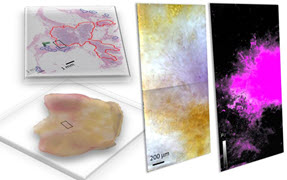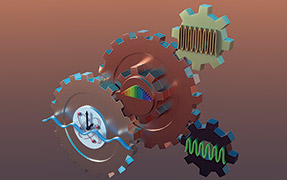Astronomical Telescopes + Instrumentation
In Edinburgh, Scotland, 26 June - 1 July.
Last September, scientists observed gravitational waves for the first time — 100 years after Albert Einstein’s theory of relativity had predicted the existence of these ripples in the fabric of space-time. At the 2016 SPIE Astronomical Telescopes + Instrumentation symposium in June, Martin Hendry of University of Glasgow (UK), will give a plenary talk on how this discovery can open new windows on the universe.
Hendry’s talk will cover the history and current status of the emerging field of gravitational-wave astronomy, highlighting, he says, “the remarkable technology that underpins a range of projects spanning the gravitational-wave spectrum.”
This biennial symposium takes place 26 June – 1 July in Edinburgh, Scotland, and offers more than 2500 presentations across 12 conferences. Key areas to be covered include ground-based and airborne instrumentation; adaptive optics systems; observatory operations; software and cyber infrastructures; and optical and mechanical technologies.
A two-day industry exhibition of astronomical instruments and technologies will be 28-29 June in conjunction with the technical events.
Other plenary talks include:
- Studying the Birth and the Fate of the Universe Using Multi-Object Spectroscopy by Hitoshi Murayama of University of California, Berkeley (USA) and University of Tokyo (Japan)
- Today’s Visions, Tomorrow’s Telescopes by George Helou of California Institute of Technology (USA)
- Let There Be Light: The Observational Quest for the First Galaxies by Richard Ellis of the European Southern Observatory (ESO) in Germany and University College London (UK)
- The X-ray Astronomy Observatory (ASTRO-H) by Tadayuki Takahashi of the Institute of Space and Astronautical Science (Japan)
- From the Low-Frequency Array for Radio Astronomy (LOFAR) to the Square Kilometre Array (SKA): The New Era of Radio Astronomy by Raffaella Morganti of the Netherlands Institute for Radio Astronomy and University of Groningen
- Imaging of Extrasolar Planets: Results and Perspectives, by Anne-Marie Lagrange of CNRS, Institut de Planetology et d’Astrophysique de Grenoble (France)
- Surveying the Sky with the Large Synoptic Survey Telescope (LSST): Software as the Instrument of the Next Decade, by Andrew Connolly, University of Washington (USA)
The theme for this year’s symposium is “His itur ad astra” – “With these, we go to the stars” – words spoken by Scotsman James Gregory in 1663 after designing a reflecting telescope known today as the Gregorian telescope.
“His work in mathematics was among the most original and far-reaching of its time,” notes Fred Watson of the Australian Astronomical Observatory, who will give a talk on Gregory and his contributions to optics, which include the discovery of diffractive grating. Watson’s talk, on Thursday, 30 June, is part of a lecture series open to the general public.
SPIE member Sarah Kendrew of Oxford will chair an Astronomy Hack Day on Thursday 30 June. This all-day open event offers developers the chance to work on software, engineering, or hardware projects such as those used to remotely control a telescope system or to process, represent, and/or visualize astronomical datasets.
Speaking at the SPIE Women in Optics luncheon, Monday 27 June, is Dame Jocelyn Bell Burnell of University of Oxford (UK) and Trinity College, Dublin. As a postgraduate in 1967, Bell Burnell discovered the first radio pulsars.
On Tuesday, 28 June, a gender-equity panel led by SPIE Fellow Claire Max of the University of California Observatories will present effective ways to increase gender diversity in the adaptive optics community. This conversation follows up the gender equity presentations given at the 2014 SPIE adaptive optics conference and the 2015 Adaptive Optics for Extremely Large Telescopes (AO4ELT4) meeting.
Also on Tuesday, SPIE offers a lunch with the experts to students who want the opportunity to network with optics and photonics experts as they offer advice and share their career experiences.
Onsite courses, taught by astronomy experts from around the world, will cover systems engineering; adaptive optics; optics analysis; visible and NIR spectrograph design and development; and related topics at introductory and intermediate levels.
| Symposium chairs for SPIE Astronomical Telescopes + Instrumentation are SPIE Fellow Colin Cunningham of the UK Astronomy Technology Center and SPIE Senior Member Masanori Iye (far right) of the National Astronomical Observatory of Japan. |  |
 |
Cochairs are Allison Barto of Ball Aerospace & Technologies (USA) and Suzanne K. Ramsay of the European Southern Observatory.
The software Hack Day at the 2014 SPIE Astronomical Telescopes + Instrumentation symposium brought together 25 instrument developers and designers to work with others on software to remotely control a telescope system and on innovative ways to process, represent, and/or visualize astronomical datasets.
A summary of four of the projects from that first SPIE Hack Day is available in the SPIE Digital Library.
Daily news reports and photos from SPIE Astronomical Telescopes + Instrumentation 2016 will be posted during the week, and followers of @SPIEevents on Twitter are encouraged to uses the hashtag #SPIEastro when posting about the event.
More information about SPIE Astronomical Telescopes + Instrumentation 2016
- Have a question or comment about this article? Write to us at spieprofessional@spie.org.
- To receive a print copy of SPIE Professional, the SPIE member magazine, become an SPIE member.



